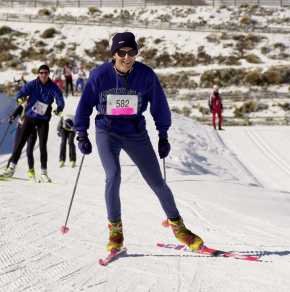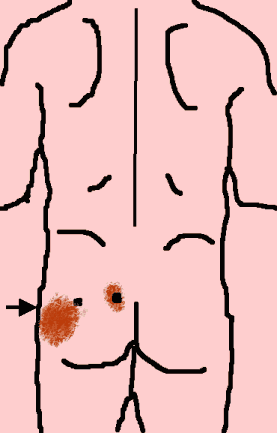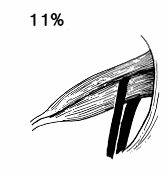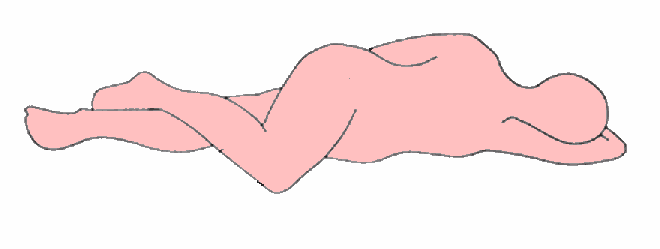This article is unique in that it
explains the Faulty Posture and Movement Patterns that trigger and perpetuate Piriformis Muscle
Syndrome. It also covers various aspects of management and cure. Make sure
that you get the help and advice of health professionals,
(especially therapeutic massage specialists), but also remember that there is only
one person in the world equipped to work on your cure 24 hours a day, and that is you!
If you need encouragement before you start the main article,
please read Piriformis Syndrome Cure - my Personal Story.
Good luck!
The Author: Happy on Skis just 14 months after the onset of Piriformis Muscle Syndrome.

The Movement Pattern that causes Piriformis Muscle Syndrome:-
(Correct this pattern, and your Piriformis muscle will eventually cure itself)!
- Thigh bone swung too far back (hip joint hyper-extension).
- Knee pointing too far outward (hip joint lateral rotation).
- Thigh bone swung too far out to the side (hip joint abduction).
|
You can see this in the following cartoon pictures of golfers at the end of their swing:-
|
Picture to Left: Piriformis Muscle Syndrome in the making:
Junior perfectly demonstrates the Piriformis Syndrome Position! - There are many joints
taken well beyond their strong middle range. Note especially the positioning of the right hip
joint (see text above for precise description).
Picture to Right: Healthy movement pattern:
Approximates what we expect to see in a professional golfer.
No joint is taken outside of its strong middle range. Note that the knee is bent, and this is the key to keeping the
hip joint and surrounding muscle within its strong middle range.
|


|
The reason that this movement pattern triggers piriformis syndrome is two fold:-
- The Gluteus maximus is slow to activate in this positioning,
leaving the Piriformis as the sole muscle of control for the rotational movements of the hip.
- The Piriformis muscle is being asked to do its solo effort working over its shorter range.
(A muscle cannot achieve maximal strength outside of its "strong middle range").
The Posture Type that encourages the Movement Pattern of Piriformis Muscle Syndrome:-
Sway back, Note:-
- The shoulders are behind a line through the back of the buttocks - hence the term "sway back".
- The knees are fully locked, or "hyper-extended", as are the hip joints.
- The Gluteal development is poor: This guy is "flat-assed"!
Sway back is common in western peoples. It is not to the best of my knowledge seen in "primitive"
peoples that walk bare foot and habitually deep squat(ref."Gluteus
maximus - Beauty is in the eye of the beholder). The best way to
cure the above postural faults is to engage the "Gluteus maximus": and to lean slightly forward:
both at heel strike, and when you feel tempted to put your hip
joint into the "Piriformis position".
|
 |
Piriformis Syndrome Symptoms
The patient with Piriformis Muscle Syndrome typically complains of
tenderness in the buttock, and difficulty with prolonged sitting. A 20 minute
brisk walk or run will cause an acute flare up for a number of days.
There may be sciatic pain down the side of the leg and foot. There may also be pain and
stiffness just above the sacrum and along its entire edge on the affected side.
Diagram Right:-
Red: regions of Buttock Pain;
Arrow: points to top of
Greater Trochanter (top of thigh bone);
Black dots close to the pain patterns: Location of
Piriformis trigger points (More info - Triggerpoint Therapy Workbook...).
|

|
Piriformis Syndrome Muscle Diagram
The diagrams to the right show the Piriformis in relation to the Sciatic nerve.
When the Piriformis muscle becomes inflamed and swollen, it may press on the sciatic nerve.
Even if the piriformis does not press on the siatic nerve, the muscle and its
trigger points can still be painfully acute (More info...Triggerpoint Therapy Workbook...).
88% of people have the whole nerve passing under the belly of the piriformis, while
11% of people have a branch of the siatic nerve passing through the belly of the piriformis.
This anatomical variation finding bears almost no relationship at all as to whether
or not you will develop sciatic nerve pain
alongside your piriformis muscle inflammation(19).
|


|
Piriformis Muscle Syndrome is most commonly a Problem of Poor
Posture and Movement patterns rather than Overuse!-
- It is common in golfers, skaters, skate style cross country skiers (both of
whom are pushing off a leg that is close to the faulty hip joint positioning that has already been
described), and cross country runners who regularly run hills.
- Piriformis Syndrome may also be due to repetitive strain at your place of work.
- Sitting still for long periods potentiates the trigger points at the heart of your
Piriformis Syndrome (more info, refer Triggerpoint Therapy Workbook...).
- Occasionally blunt trauma (a fall on the buttock) will trigger Piriformis syndrome. Obviously,
this is not primarily due to poor patterns of posture and movement, but you are
still likely to get some benefit from improving your patterns of use. (See comments re: surgery below).
- Sitting on your wallet or other sharp object (fat wallet syndrome).
- Sitting cross legged is also a suggested cause,
but this may more likely be associated with the less widely recognised condition "posterior
gluteus medius muscle strain".
In fact, if you have had a diagnosis of Piriformis Syndrome and cannot identify
the movement faults that I describe, you may have
"Posterior Gluteus medius strain" instead of or in addition to your Piriformis diagnosis.
Posterior Gluteus medius strain
is more common than Piriformis syndrome, but usually is not quite so acute, and
most people can live with the pain without seeking a cure. Posterior Gluteus medius strain
is not the topic of this article, but note that gentle stretches, trigger point massage and Gluteus maximus
activation will help (Further info.(Triggerpoint Therapy Workbook....
The Movement Pattern Cure for Piriformis Muscle Problems:-
- Avoid the "sway back" movement pattern - that is,
lean forward a little, and do not let your knees lock. This will feel strange.
In fact, it is easy to describe and very hard to do.
The following two exercises will help.
- Engaging Gluteus maximus at heel strike.
- Performing the Runner's Squat to encourage Gluteus maximus engagement.
(Note: Provided your Transversus abdominis muscle is working properly, see
The Transversus abdominis muscle and the Zip and hollow), a fully functional
Gluteus maximus will automatically stop you swaying backwards and locking your knees,
and this will automatically stop your hip joint going into hip hyper-extension).
The Massage and Stretch Remedies for Piriformis Muscle Problems:
Trigger point Massage: very useful cure, but keep in mind that trigger points
in one muscle encourage trigger points in neighbouring muscles.
Trigger point therapeutic massage of the
entire buttock area plus the lower back is required, in conjunction with tennis ball self massage
(further info...Triggerpoint Therapy Workbook...).
Stretching: Useful if done correctly. Most of the stretches illustrated on the Internet are not specific to
the Piriformis. Many of them are not particularly safe. There is only one correct positioning
for stretching the Piriformis: The "FAIR" position (Hip joint Flexed, Adducted and
Internally Rotated - note that this is
the mirror image description of the hip joint positioning described above under
"Movement Pattern that causes Piriformis Muscle Syndrome").
It is illustrated here:-
Diagram: The Supine True Piriformis stretch as advocated by Clair Davies(22).
Standing True Piriformis Stretch: Lean against a wall and apply the same positioning (not illustrated). |
 |
Side lying True Piriformis Stretch in the "FAIR" position as advocated by Dr.
Loren Fishman and associates
(19). |
 |
Stretch Instructions:
Be very gentle, but repeat frequently through the day - for example if the muscle problems are acute,
get up from your chair every 20 minutes and do the following.
Ease your knee further across the line of your body, and hold for 3 to 5 seconds. Ease the pressure off and
pause for a second. Repeat for a total of one to two minutes. (Preferably,
do some trigger point massaging prior to stretches - Triggerpoint Therapy Workbook...). It is wise to perform a full set of Gluteal Stretches
(Not illustrated here) and not just the piriformis muscle stretch because short weak muscles
never occur in isolation, and trigger points always attract more trigger points.
Piriformis Syndrome Cure - Timing
Once an effective posture movement re-education program
and trigger point and stretch therapy is in place, expect it to take 2-3 months to know that life
will eventually be worth living again, and 6 months to be able to resume more or less full work load.
Even after 36 months, expect to notice some Piriformis sensitivity when applying a stretch
in the "FAIR" position described above.
Doctors who treat Piriformis Syndrome may advocate the following:-
- Trigger Point dry needling. I have had this done myself. It brought partial cure,
but it neglected the fact that
"trigger points breed trigger points". You need to attend to all trigger points in all the surrounding
muscles, and not just stick needles in the most obvious one!
Simple trigger point "ischemic compression" (pressure with thumb, elbow or tennis ball)
followed by frequent gentle stretching and short walks is much more adaptable home remedy.
- Injections of Saline, local anaesthetic or corticosteroid in the trigger point are all workable treatments,
but rely upon very precise application, which is not easy. The above comments about neglecting other trigger points
apply.
- Botox injection causes flaccid paralysis of the muscle. It is injected into the body of the muscle
and works by blocking all transmission between the motor nerve and the muscle.
Note that this is not a quick cure.
The Botox paralysis in the hands of an experienced surgeon works for months, but note that this
intervention is not fully reversible (the muscle will recover maybe 90% of its strength after 12 months),
and should not be used as a "first" or a "stand alone" remedy.
It takes 14 days for a difference to be noted, with measurable improvement 2 to 6 months later.
(21).
- Piriformis muscle surgery to sever the muscle at its femoral attachment
is rarely recommended nowadays, but may be appropriate when there has been
a blunt trauma to the buttock with resultant scar tissue build up between the sciatic nerve and the piriformis
muscle.
Surgery is a last resort cure, and the surgeon should additionally offer "neurolysis" (freeing of the scar tissue
around the sciatic nerve). In selected cases, an experienced surgeon achieves good rates of cure.
(20).
Piriformis Syndrome Cure - My personal Story:-
I was performing some hard 3 to 6 minute intervals and just beginning some 15 to
30 second sprint intervals, both on roller skis and on the bicycle.
And then that post exercise muscle ache arrived... and persisted...
and worsened...
It started during the build-up to a 42 km ski race.
There is nothing so devastating for the competitive endurance athlete as
unexplained pain. At its worst, 20 minutes of brisk walking
would have me in agony for the next three days,
and sitting for prolonged periods became an endurance exercise in pain.
|
 |
The pain patterns were typical enough for Piriformis Muscle Syndrome:-
- Pain over the buttock toward the greater trochanter.
- Lumbo-sacral pain and right sacro-iliac joint pain which was especially bad
in the morning when getting out of bed. At its worst, putting my back into lumbar lordosis (lumbar extension)
was excruciating.
- There was no sciatic pain, and the physiotherapist confirmed a negative slump test.
The pretzel stretch that I found on the internet made things worse so I gave up on the stretch cure.
Physiotherapeutic dry needling made an almost imperceptible difference. And then came the day of amazing discovery:
4.30 am on a stormy Sunday morning and I lay awake thinking about all my past
mountaineering experiences. My mind dwelt upon the fact that during all my New Zealand alpine
expeditions I had never the slightest problem of back or buttock pain! And this despite carrying
packs of 30 kgs or more! Could this be my solution? A way out? A chance at a race day reprieve?
A question formed in my mind:-
- What would happen if I put a heavy pack on my back and then did some roller skiing?
The thoughts kept circulating during that stiff pre-dawn darkness:-
What would happen if I put a heavy pack on?...
What would happen if I forced myself to lean further forward?
Was there even a suitable weight in the garage to put in the old broken-framed mountaineer's pack?
A Stormy Cure...
It was not long before I arrived at the local car racing track. It was still pre-dawn, about 7.00 am and the
rain and wind were cold and ferocious. I slipped the gloves on, put the 20 kg pack
on the back and with the thought of, "do or die Bruce!", I clipped
into the roller ski bindings, and began to ski -
Cautiously at first, hidden under a layer of best Gortex
mountaineer's coat, I stepped out and skate skied blind on the 2.6 km track. It felt OK! The pain was
no worse! Second round. Working hard not to be blown backwards. Then the home straight...
The wind crescendoed to full force as a hail stone laden Southland cold front drove into my face.
I was pushing hard but cautiously, skiing bent low. The wind was not beating me back! The pain was holding at
a bearable level! I started to laugh wildly and insanely! The pain was not growing! I could beat it!...
It was an emotional moment. It was my introduction to the power of the "posture movement
awareness" remedy for muscluoskeletal pain.
As long as I skied with a pack on my back, or imagined that the pack was there, the pain would not
worsen, I could race my race and hope for eventual cure.
On race day, the snow was soft. It was like skiing through mud. I did the shorter 21 kms race.
The proprietor of the ski race (who knew that I had Pirifromis Muscle Syndrome) asked me, "how was the race?" -
"My pain's no worse than when I started!" was my reply. I was grinning from ear to ear.
That was the start of my gradual improvement and cure as I learnt the
marvels of "posture-movement awareness". First I learnt to engage the Gluteus maximus to correct a
severe sway back. Then I learned to stop the knees collapsing inwards. Then I learned
to breathe comfortably during time trial running. Then I learned to adopt
correct head and neck positioning, and
my accuracy with intra-venous injections in cats sky-rocketed! (I'm a veterinarian) - It would be a lie to say
that I don't have any pain at all, but I know I can manage what small amount of pain I do have.
I also learnt the value of Pilates, gentle dynamic stretching, and trigger point
and other forms of massage. I now keep a much more open mind about alternative therapeutic modalities!
I hope that this story of Pirirformis Syndrome Cure is of benefit to you!
Feel free to make a donation!

Thank you!
God bless, and good luck!
Piriformis Syndrome has a Cure!
Bruce Thomson
References:
- David Chapman-Smith: "The Chiropractic profession: Its Education, Practice,
Research and Future Directions" Publ. NCMIC Group Inc. West Demoines, Iowa.
2000 ISBN 1-892734-02-8
- Wayne Milicich: "Move like a Child": Publ. Optimum Publishing Limited.
Hamilton New Zealand.
- Shirley A Sahrman: "Movement Impairment Syndromes" Publ. Mosby, 2002
ISBN 0-8016-7205-8
- Michael Warburton: Barefoot Running publ.
http://www.sportsci.org/jour/0103/mw.htm
- Vleeming A, et al. The posterior layer of the thoracolumbar fascia.
Spine 1995;20(7):753.
- Hodges PW, Richardson CA: Contraction of the abdominal muscles associated
with movement of the lower limb; Phys Ther 1997 Feb;77(2):132-44
- Bergmann G, Kniggendorf H, Graichen F, Rohlmann A (1995). Influence of shoes
and heel strike on the loading of the hip joint. Journal of Biomechanics 28, 817-827
- Robbins SE, Hanna AM (1987). Running-related injury prevention through
barefoot adaptations. Medicine and Science in Sports and Exercise 19, 148-156
- Warren Hammer,MS,DC,DACBO
http://www.chiroweb.com/archives/17/16/21.html
- Bruce Thomson: OBP of Tennis Elbow (go to the bottom of the page to view
the muscle length-strength chart);
http://www.easyvigour.net.nz/fitness/hOBP2_Cures_Tennis_Elbow.htm
- Zola returns without regrets
http://www.telegraphindia.com/1030408/asp/sports/story_1851824.asp
- Bruckner P, Khan K: "Clinical Sports Medicine", Second Edition. Publ.
McGraw-Hill Australia 2001. ISBN 0 074 71108 3
- Kim Christensen,DC,DACRB,CCSP: Chondromalacia Patellae and Orthotic Support
http://www.chiroweb.com/archives/19/25/02.html
- Wheeless' Textbook of Orthopaedics: Gluteus maximus anatomy and function, Piriformis muscle anatomy and function
http://www.ortho-u.net/05/208.htm
- (Leinonen at al, 2000. Arch Phys Med Rehab, 81, pp 32-37).
- Jeff Erickson: Simple Ankle Sprains?; http://childrenshosp-richmond.org/pdf/VOL3_NO4.PDF
- Michael Yessis: Explosive Running, Using the Science of Kinesiology to Improve Your Performance.
Publ. Contemporary Books, Chicago 2,000. ISBN 0-8092-9899-6
- Bullock-Saxton JE; Janda V; Bullock MI:Int J Sports Med 1994; 15 (6) Aug: 330–334
- Diagnosis and Cure of Piriformis Syndrome - http://www.sciatica.org/piriformis.html
- Posttraumatic Piriformis Syndrome: Diagnosis and Results of Operative Treatment - http://www.coccyx.org/medabs/benson.htm
- Scientists solve the mystery of how Botox attacks nerves and eliminates wrinkles - http://www.brightsurf.com/news/dec_04/EDU_news_121304_b.php
- Clair Davies: Triggerpoint Therapy Workbook
(Piriformis Muscle Cure, pgs. 173 to 175). Publ. New Harbinger Publications 2001
- Physical Characteristics of the Andmanaese and Khoisan - http://www.andaman.org/book/chapter5/text5.htm
- Craig Liebenson: Balance Exercises - http://gymball.com/balance_exercises.html
Piriformis Syndrome Cure © Bruce Thomson, EasyVigour Project

Return to top...
© Bruce Thomson, EasyVigour Project

|
|
|
|
Film Footage of Bushman Walking and Running!
Two classic low budget comedies from the 80's.
The first disc has a documentary feature on the real life of star
N!xau who played Xixo.
"If you're willing to laugh at
yourself, pick these up!"
(Mark Baker, Amazon.com review)
|
|